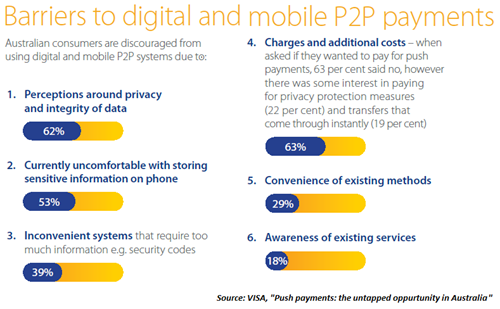-
The financial services industry in Australia has rightfully earned a reputation around the world for leading the way in innovation, particularly in payments.
Australians remain the world's biggest users of contactless payments. We're early adopters of mobile payment solutions at the point of sale, taking advantage of the multiple services already live in our market and we're active online shoppers.
"Banks still have everything to play for here, and developing a strong P2P payments service now will lay the tracks for further growth and payments evolution in future."
Robert Walls, Head of Product, Visa Australia, New Zealand & South Pacific at VisaYet there is one Australian segment where services have not kept pace with changing consumer trends: paying each other. We can tap our cards or our phones in-store; we can order and pay for a coffee or a car service in a few clicks.
But when it comes to splitting bills across a household, paying a gardener or babysitter or sending money to a family member overseas, Australians are reliant on cash or electronic funds transfer (EFT) - the same methods we've used for years.
ONE OUT
In this digital and mobile peer-to-peer (P2P) payment market, Australia lags other markets significantly. In some markets, these payments are growing at a rapid rate as consumers seek better, faster and cheaper ways of sending money.
In the United States, 22 per cent of smartphone owners and 28 per cent of tablet users make P2P payments via mobile applications. In China 24 per cent of smartphone owners report regularly usimg their device to send money to other people and 34 per cent of smartphone owners do the same in India.
Yet only 13 per cent of Australians have transferred money using their bank's app, while just 1 per cent have used a third party app dedicated to mobile payments or a social media platform to send or receive funds, according to Visa research.
If we're ahead of these same markets in embracing new ways to pay, why is Australia's adoption of P2P payments still in its infancy? Visa asked this question in a new report on the untapped opportunity in Australia for P2P payments.
According to market analysts Ovum, the major factors affecting consumer usage are largely a lack of awareness amongst consumers and an overall clunky user experience.
There are few truly universal options available to consumers enabling fast transfers using a mobile number, email address or social ID. This has resulted in a fragmented P2P environment, where consumers are unsure of what's available to them and lack confidence these services will offer a good experience and send the money where they want it to go.
Again looking to overseas markets, a simple, user-friendly and trusted interface is key to P2P adoption. Products delivering that experience are gaining traction.
In the United States, P2P payments are at a tipping point of significant growth, especially among millennials. US households made more than USD $1.2 trillion in P2P payments in 2014, an increase of around 40 per cent since 2010.
{CF_IMAGE}
The views and opinions expressed in this communication are those of the author and may not necessarily state or reflect those of ANZ.
-
anzcomau:Bluenotes/technology-innovation,anzcomau:Bluenotes/technology-innovation/payments
P2P and Australia's payments gap
2015-11-30

